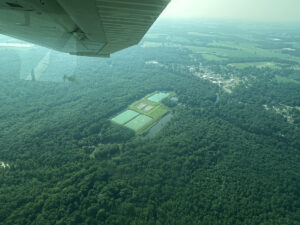News

Waste Samples Falsified in Attempt to Dump more Pollution Than Law Allows

An investigation by two state agencies revealed efforts to cook the books and mislead regulators about the content of 55 waste lagoons at 35 hog operations in eastern North Carolina. The North Carolina Department of Environmental Quality (DEQ) released 8 of the 35 letters mailed to operators as part of an ongoing investigation.
All of the facilities in question engage in industrial meat production and DEQ permits each of them to use the lagoon and sprayfield system to dispose of their enormous volumes of animal waste. The animals are housed over slatted floors where waste accumulates beneath them and is periodically flushed from the barns into an earthen pit (i.e., lagoon) and then sprayed, typically through industrial-sized sprinklers, onto sprayfields nearby.
“This is a blatant attempt by industrial hog operators, 35 of them, to lie to regulators in order to dump more pollution into our communities and environment,” stated Upper Neuse Riverkeeper, Matthew Starr
The DEQ permits are supposed to prevent this waste management method from threatening nearby communities and waters with bacteria, nutrient and heavy metal pollution. Preventing that threat requires monitoring and limiting waste disposal based on the concentration of various pollutants in the waste stream. The permit requires sampling of the waste, within 60 days of the start of spraying, for two nutrients (nitrogen and phosphorus) and two heavy metals (zinc and copper). Spraying may be prohibited when nutrient or heavy metal levels in the sprayfields are too high.
The 35 facilities investigated had collected lagoon samples and sent them to the NC Department of Agriculture and Consumer Services laboratory in March. Lab technicians analyzed those samples and alerted DEQ staff in the Division of Water Resources (DWR). On Friday, April 13th, DEQ inspectors collected samples from all the facilities on the same day. The samples were sent back to the lab for analysis, and comparison of the results suggested serious problems indicating a widespread effort to defraud government regulators at the expense of public health and the environment. The first facilities reported on Monday are located in Duplin County, within the Cape Fear watershed. More than 2.5 million hogs are housed in over 250 industrial facilities in the Neuse and Tar-Pamlico River basins, predominantly east of I-95.
The difference between the pollutant concentrations in the samples submitted by operators and those collected by DWR is astounding. Nitrogen levels were, in most cases, much higher—as much as 291% in one lagoon—above those originally reported. Phosphorus levels varied, but at one lagoon, levels were 1182% higher than those originally reported. But the greatest discrepancy by far was found in the level of heavy metals reported. Each of the 8 facilities for which DWR provided records grossly underreported the levels of zinc and copper in their waste stream. The levels of zinc were misreported by as much as 101,108%. The difference in levels of copper was as great as 34,955%.
Copper and zinc can be toxic at high levels to fish and other aquatic life. The Neuse and Tar-Pamlico Rivers continue to suffer from nutrient pollution, in part caused by industrial agriculture. Nutrient pollution leads to algal blooms and fish kills that creates unsafe swimming conditions during the summer months. In 2016, state officials warned the public to avoid algal blooms on the Pamlico River. In freshwater reservoirs, nutrient pollution can lead to harmful algal blooms, impacting drinking water supplies. The Neuse and Tar-Pamlico Rivers provide drinking water for more than 2 million residents. The Cape Fear River, impacted by the heaviest concentration of industrial swine operations, also suffers from bacteria and nutrient pollution.
“Clearly we need increased transparency from the industry, better laws from our elected officials and strong enforcement by our state agencies in order to protect our water resources and our communities that rely on them”, stated Forrest English, Pamlico-Tar Riverkeeper. He continues, “We cannot continue to rely on self-monitoring to protect us from an industry caught, repeatedly, disregarding the law and putting our communities and waters in jeopardy.”
Related News

Riverkeeper monitoring Tar-Pamlico Water Trail
July 25th 2024

Rain ramps up trash-trap cleanouts
July 25th 2024

Riverkeeper, intern take on emergency trash trap cleanout
July 25th 2024

Tar-Pam Riverkeeper investigates Cub Creek turbidity
July 25th 2024

Heavy rains lead to sky-high turbidity on Lick Creek
July 25th 2024

Riverkeeper: What goes up, must come down
July 18th 2024

Greenville’s trash trap gets emergency cleanout
July 18th 2024

Sound Rivers gets close up of cyanobacteria
July 18th 2024

